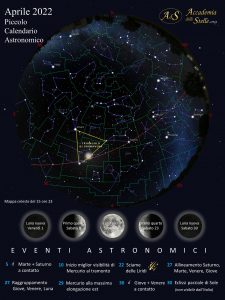Scuola di Archeoastronomia 2022 VI ed.
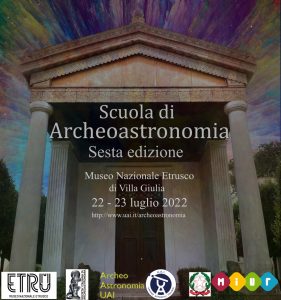 Si terrà venerdì 22 e sabato 23 luglio 2022 la sesta edizione della Scuola Nazionale di Archeoastronomia della UAI. L’evento sarà ospitato nella prestigiosa sede del Museo Nazionale Etrusco di Villa Giulia a Roma e le sessioni didattiche si potranno seguire anche in streaming (qui le modalità di iscrizione). Continua a leggere
Si terrà venerdì 22 e sabato 23 luglio 2022 la sesta edizione della Scuola Nazionale di Archeoastronomia della UAI. L’evento sarà ospitato nella prestigiosa sede del Museo Nazionale Etrusco di Villa Giulia a Roma e le sessioni didattiche si potranno seguire anche in streaming (qui le modalità di iscrizione). Continua a leggere
La cometa C/2017 K2 (PanSTARRS)

La mappa riporta la posizione della cometa C/2017 K2 (PanSTARRS) (linea curva) con divisioni ogni 5 giorni. Courtesy Emil Bonanno / MegaStar, via Sky&Telescope
La cometa C/2017 K2 (PanSTARRS) è adesso visibile comodamente nei nostri cieli, ecco la carta per individuarla. Continua a leggere
Cielo del mese – luglio 2022
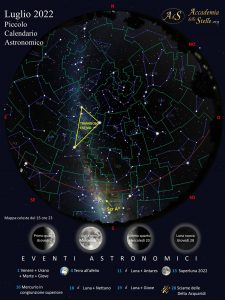 CIELO DI LUGLIO 2022 – I fenomeni astronomici di luglio 2022, con la visibilità di stelle, pianeti e costellazioni.
CIELO DI LUGLIO 2022 – I fenomeni astronomici di luglio 2022, con la visibilità di stelle, pianeti e costellazioni.
Luglio, il mese della Scuola di Archeoastronomia, della cometa C/2017 K2 (PanSTARRS), e del ritorno dei pianeti a orari comodi Continua a leggere
Solstizio d’estate
Cielo del mese – giugno 2022
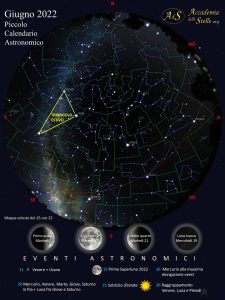 ✨ Cosa si osserva in cielo?
✨ Cosa si osserva in cielo?
⭐️ CALENDARIO ASTRONOMICO DI GIUGNO 2022
I fenomeni astronomici del mese, con la visibilità di stelle, pianeti e costellazioni.
Continua a leggere
Vacanze Astronomiche estate 2022 II
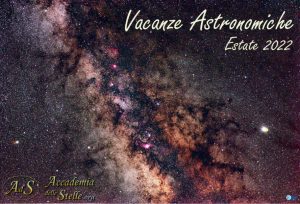 Per la seconda edizione dell’estate 2022 le Vacanze Astronomiche di Accademia delle Stelle saliranno ai 1400 metri di quota del Grand Hotel delle Rocche, a Rocca di Mezzo (AQ), nel Parco Naturale Regionale Sirente-Velino. Le Vacanze Astronomiche sono un’occasione preziosa per tutti gli appassionati di astronomia, di qualsiasi livello, per osservare da un cielo buio incontrando altri astrofili e imparando qualcosa di nuovo sul proprio hobby. Continua a leggere
Per la seconda edizione dell’estate 2022 le Vacanze Astronomiche di Accademia delle Stelle saliranno ai 1400 metri di quota del Grand Hotel delle Rocche, a Rocca di Mezzo (AQ), nel Parco Naturale Regionale Sirente-Velino. Le Vacanze Astronomiche sono un’occasione preziosa per tutti gli appassionati di astronomia, di qualsiasi livello, per osservare da un cielo buio incontrando altri astrofili e imparando qualcosa di nuovo sul proprio hobby. Continua a leggere
Il nuovo orologio solare del Parco delle Valli
 Si è tenuto a Roma lo scorso sabato 7 maggio l’emozionante battesimo di un nuovo orologio solare. Continua a leggere
Si è tenuto a Roma lo scorso sabato 7 maggio l’emozionante battesimo di un nuovo orologio solare. Continua a leggere
Vacanze Astronomiche estate 2022
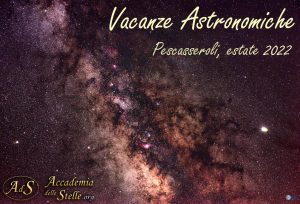 Tornano le Vacanze Astronomiche di Accademia delle Stelle! Un’occasione preziosa per tutti gli appassionati di astronomia, di qualsiasi livello, per osservare da un cielo buio incontrando altri astrofili e imparando qualcosa di nuovo sul proprio hobby. Continua a leggere
Tornano le Vacanze Astronomiche di Accademia delle Stelle! Un’occasione preziosa per tutti gli appassionati di astronomia, di qualsiasi livello, per osservare da un cielo buio incontrando altri astrofili e imparando qualcosa di nuovo sul proprio hobby. Continua a leggere


